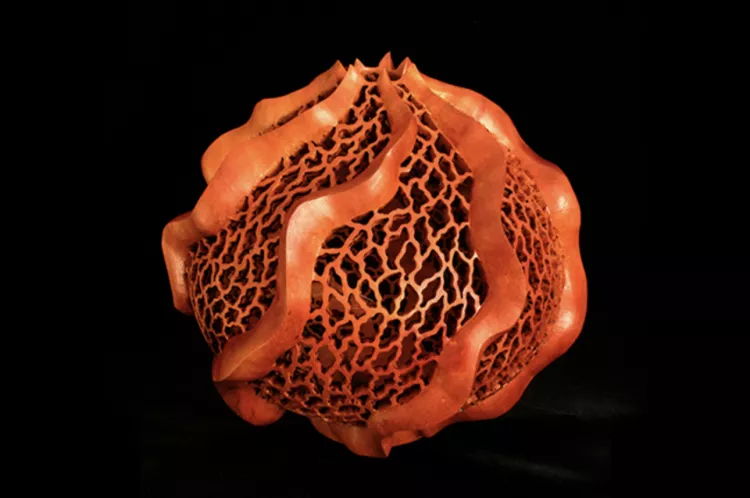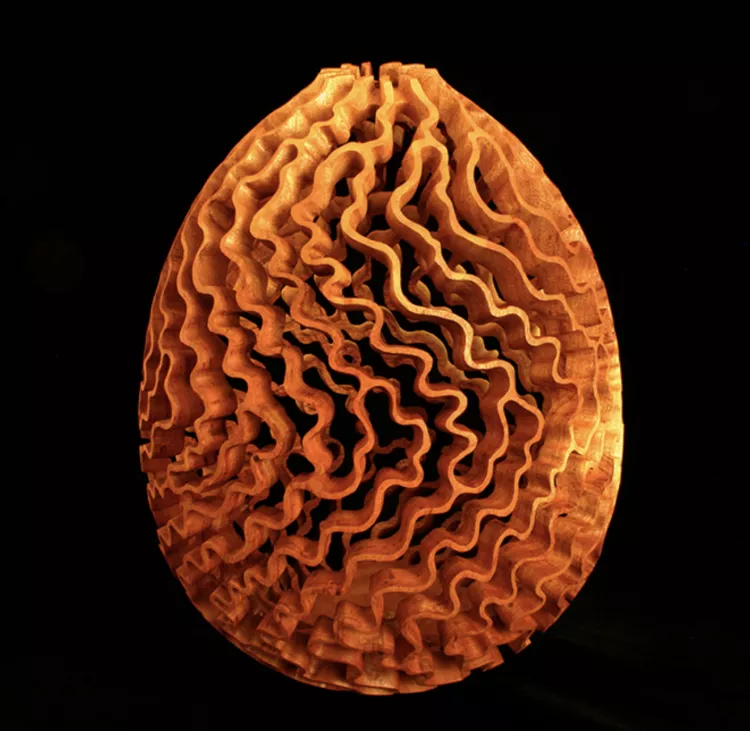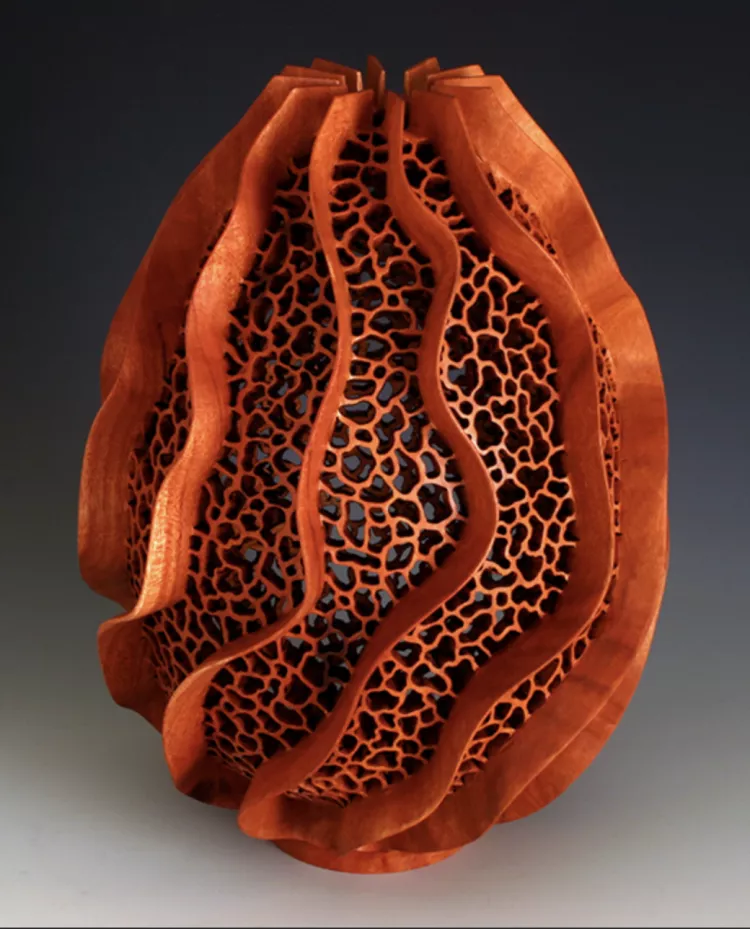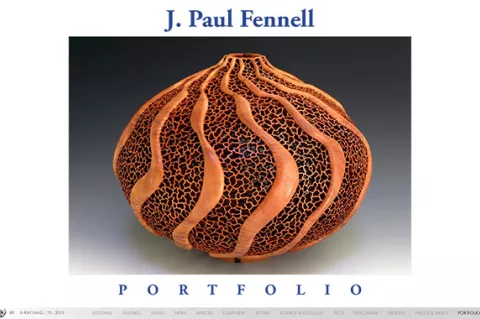American artist and woodturner J. Paul Fennell carves wood into delicate and fluid vessels inspired by the movement and dynamics of the sea. Brought up by the ocean on the East Coast, this former engineer of the Apollo space program is now based in Arizona where he re-purposes exotic urban trees destined for the bin and transforms their wood into sublime sculptures.
Contributed by
X-RAY MAG: Tell us about yourself, your background and how you became an artist.
JPF: Wood has always been part of my life. I was born and raised in Beverly, Massachusetts, on the coast north of Boston, where my home directly faced the Atlantic Ocean. At a very young age, my earliest memories of woodworking were that of sawing and nailing scraps of wood cutoffs together in my dad's basement workshop; I will always remember the pleasant aroma arising as he worked with freshly-cut wood. However, education was taken very seriously in my family, and as a result of my interest and curiosity of how things worked, my college experience resulted in receiving Bachelor and Master of Science Degrees in Engineering from Ohio State University and University of Southern California respectively. Just out of school, I was employed in the Apollo Space Program for a number of years—one of the most exciting times in my life, contributing to sending men to the moon and back.
During that time, I returned to woodworking mainly as a form of therapy, with a desire to work with my hands to balance the intense mental activity required in the analytical rigors of engineering. At a local high school, I had the opportunity to turn wood on a lathe, and have never looked back. Over time, I developed skills and techniques to create aesthetically, finely crafted hollow forms and vessels out of exotic woods. From there, more expressive and narrative work evolved through embellishment techniques and processes, to the extent that my work now resides in more than 15 museums as well as numerous private collections. The narrative aspect of my work stems from a deep reverence of personal experiences, one of which has been directly influenced by growing up with the ocean close by.
X-RAY MAG: Why marine themes? How did you come to concepts in wood focusing on the sea and how did you develop your style of sculpture over time?
JPF: Living in such a close proximity to the ocean, one cannot escape its beauty, power and majesty. In the summer evenings with the windows wide open, one could hear the soft, hypnotic lapping of waves on the beach. At other times, the fury of hurricanes would unleash the ocean’s raw power, amazing me in the unrelenting release of so much energy and movement onto the beach. During more serene times, observing the shifting patterns created on a sandy bottom of the sea by sunlight reflecting off the waves was mesmerizing.
As an artist, my work evolved as a form of self-expression, thereby becoming a non-verbal “language” in my medium of choice, to relate to the world my persona, experiences and influences that are an important part of who you are. It was a natural extension then, to focus on a significant component in my upbringing—the sea. Working with wood—my medium of choice—over a number of years, I created design elements to express both wave and reflected sunlight patterns onto my work, refining the concept to a more abstract fashion over time. Additionally, I was inspired by other marine-related themes to reflect the power and inherent danger of the sea, as evidenced in the pieces Coriolis and O’er the Bounding Main. For example:
- Coriolis:
Within the physical world, there is a strong interaction between ocean currents, waves and the atmosphere (wind). Everyone has seen the interplay of these phenomena in the form of breaking waves with white caps, and on a larger scale, weather systems such as storms, hurricanes and cyclones. It is about energy and movement: the effects of which are mesmerizing to watch, as when, for example, huge long waves consistently come crashing onto a beach. Within the aesthetic world, the idea of the dynamics of energy and movement has been incorporated in my work for quite some time. The concept, in abstraction, was well-put by the American painter Jackson Pollock, who explained that his expressive work was “energy made visible.”
- O’er the Bounding Main:
- “Sailing, sailing o’er the bounding main
Where many a stormy wind shall blow…”
As the lyrics to this children’s song of the late 1800’s suggest, sailing the high seas is fraught with danger, brought upon by the strong interplay of ocean currents, wind and waves. In the physical world, this can be thought of as nature’s dynamic and exhilarating display of energy and movement, familiar to anyone adventurous enough to sail the high seas.
I interpret the physical idea of the drama of the ocean’s dynamism aesthetically by creating undulating abstract wave and swirling current patterns traversing around a three-dimensional surface.
X-RAY MAG: What is your artistic method or creative process? In step-by-step terms, how do you create your artworks?
JPF: My experience of making works of art is largely rooted within the desire for creative expression, in other words, relating the story behind the piece. The medium I have chosen is wood, and stems from my deep reverence for the material since childhood. For me, one of the first physical steps of the process of making involves the lathe, a machine which allows me to explore forms very quickly, with found wood that is generally not available commercially. Most of my work concerns the aesthetic of the vessel form, one of the most relevant and oldest artifacts of human civilization: it is timeless and ubiquitous throughout multitudes of cultures—past and present. When these artifacts are discovered or unearthed, we learn much from societies of the past because of their particular form and unpretentious embellishment of cultural symbols and images. It seems natural to me to follow this path of creating work, through form and embellishment, that relates similarly but individually to one’s own experiences, relationships and things which are personally significant.
In the process of making, it is important to me that the material I use has minimal impact on the environment. Towards that end, my source of wood continually utilizes that which is salvaged from the local “urban forest”, a source that is amazingly diverse, even within the harsh climate conditions of metropolitan Phoenix. A vessel form is created using a lathe with hand tools to shape the outside form and to hollow out the interior. The intended design is then drawn onto the vessel surface. Because the process is subtractive, wood must be carved away to create the design, and this is performed with various power-carving tools to cut into or pierce the material.
X-RAY MAG: What is your relationship to marine life and the underwater world? In your relationship with fish and the sea, where have you had your favorite experiences?
JPF: My strongest relationship with the sea existed while growing up. Its presence was visible every day, as you only had to look out of the windows of my home or venture outside to experience it. Of course, the most favorite time was the summer, when you connected to it by swimming, boating or fishing. Other times of the year also had benefits, such as during the winter, when you could walk the beach in solitude.
X-RAY MAG: What are your thoughts on ocean conservation and how does your artwork relate to these issues?
JPF: Ocean conservation, like anthropogenic climate change, is a vital issue today because we are beginning to see and experience the consequences of long-term abuse or neglect of the environment. The ocean can no longer be considered as an infinite source of the bounty we derive from it, nor can it be a dumping ground of trash humans carelessly discard. My artwork has evolved as a “vocabulary” which in part will help promote the awareness and impact of the harmful effects of mistreating the environment. Hopefully, this effort, through the power of visual imagery and observation, will act as a catalyst to encourage and sustain efforts of conservation.
X-RAY MAG: How do you come to your ideas and what or who inspires you? What is the message or experience you want viewers of your artwork to have or understand?
JPF: My sources of inspiration come from many directions. As with many artists, patterns derived from nature are a major source, as are patterns from architecture. I have also been inspired by artists such as M.C. Escher, Rene Lalique with respect to patterns, and by Jackson Pollock with respect to the concept of “energy made visible.” To the viewer, the narratives behind my work relate to my life and to what is important to me concerning beliefs, interests and experiences. Developing the art of “seeing” to be aware of the world around you is also a message my work is meant to convey.
X-RAY MAG: What are the challenges and/or benefits of being an artist in the world today?
JPF: E.B. Hubbard’s quote comes to mind: “Art is not a thing. It is a way.” When your work is on display to the public, art is the “thing” that most are observing. However, the underlying reason why the work is made stems from the desire for creative expression, which is constantly challenged by the other side of the coin—trying to make a living at it. In today’s world, the benefits can be seen and experienced by the global presence of your work through the World Wide Web. There has never been a time like this before, and as easy for the artist to show the world your work via websites and social media.
X-RAY MAG: How do children and adults respond to your work? What insights have you gained from the process of showing your work to different audiences?
JPF: I’m not sure how children respond to my work, and I can only hope that it inspires them to think of making things with their hands as opposed to being on a computer all the time. With respect to adults, the work must elicit an interest in what the meaning is behind the piece. When that happens, it often leads to a desire to learn of the creative path the artist traversed to create the piece—from the inspiration or idea to the trials and tribulations of the process and techniques needed to successfully end up at what they are observing. I have learned that showing work to different audiences leads to different interpretations of the meaning behind the work. This is understandable, as the piece can remind the observer of something that would occur only to him or her, even though the title may suggest something completely different.
X-RAY MAG: What are your upcoming projects or events?
JPF: I am represented by several galleries, which means that there is always an on-going effort to create new work. The next significant event will be the SOFA/Chicago Art Show in November 2015, for which several pieces will be exhibited. Over the years, I have been invited to teach workshops at various art schools in the United States, and to participate in many woodturning symposiums both here and internationally. In 2016, I will be a participant in a symposium in France and one in Canada.
X-RAY MAG: Lastly, is there anything else you would like to tell our readers about yourself and your artwork?
JPF: Simply, I could not envision a life without the “way” that art creates. ■
For more information, visit the artist’s website at: www.jpaulfennell.com.
Living in such a close proximity to the ocean, one cannot escape its beauty, power and majesty.
— J. Paul Fennell


































